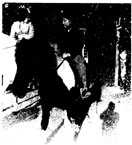
My First Riding Lesson
Finally my riding clothes came: thick brown jodhpurs, a tweed jacket, string gloves, and a hard hat. I didn’t need boots — most juniors rode in their walking shoes.
I was VERY excited. In my class were Brioney, someone who was only five, and Clare. They had all ridden before — quite a lot — and Clare had real jodhpur boots.

Clare on Frisky. They are in the stable yard; Miss Monkman is in the stable doorway.
We started in the stable yard — I had Tuppence. Miss Monkman showed me how to get on (it was much easier with a stirrup and saddle), and she made the stirrups the right length and put my feet in them; she pushed my heels down and told me to keep them down. She pushed my lower legs back a bit and pressed my knees into the saddle, and then she put my fingers around the reins, so that my two fists were facing each other with the thumbs on top, and the bottoms of my fists were pressed into Tuppence. She said, “Whatever you do, don’t let go of the reins — even if you fall off.”
She glanced at the others, told Brioney to shorten her stirrups, and then, with Tuppence’s reins in one hand, she led us out of the stable yard. We walked down the road, through the cow pasture, and into the horse pasture, with Miss Monkman holding my reins and talking to me the whole time. Finally when we got to the paddock, she let go of the reins and let me ride by myself.
I was really riding. I was on a horse, I could feel it moving underneath me, and see its mane kind of flapping up and down, and its ears flickering back and forth — listening, maybe wondering who I was.
I tried to keep the reins where Miss Monkman had put them: in my fists, with my thumbs on top, and the bottom of my hands on the pony’s withers (two bumpy bones right in front of the saddle). I held my hands still, so I wouldn’t hurt Tuppence’s mouth — Miss Monkman told me that, and I remembered what Black Beauty said about the bit, too. I pushed my toes up and my heels down.
I gripped with my knees. I sat up straight and looked straight ahead, between Tuppence’s flickering ears, keeping my elbows pressed to my sides.
I could do all those things at once while we walked.
Then Miss Monkman, who was standing in the middle of the paddock while we rode round her, called, “Trot!” and all the horses went faster and Tuppence did, too. I bumped up and down, wobbling all over the place and almost losing my balance — my arms went out, my hands jerked off the withers and into the air; but I didn’t let go of the reins.
“Libby, grab the saddle or a bit of mane if you feel yourself losing your balance! Sit up straight!” Miss Monkman shouted. “Keep your hands on the withers!”
I tried to but I kept bumping up and down and so did my hands.
“Heels down, Libby — it’s easier to balance that way!” Miss Monkman said. “Post.”
(That means watch the outside shoulder — when it goes forward, push yourself up. You can pretend there’s a string from the horse’s shoulder to the middle of your belt, pulling you up and forward. Miss Monkman had explained all that but it’s hard to do.)
“It’s a RHYthm. ONE two, ONE two. Up! Down! Post — one, two! One, two! Up, down! Count with me, come on.”
I watched and counted — ONE two, ONE two — but I still bumped. Once or twice I did actually post in rhythm — I think, I’m not sure. Most of the time I just jostled around, but I did stay on.
There was so much to think about and try to do all at once. Riding was MUCH harder than I expected; the only thing that was easy was sitting up straight.
The next day my bottom and the inside of my thighs hurt quite a lot. I asked Clare about it.
“You’re saddle-sore,” Clare said. “It’s because riding is new to you.”
“I’m not very good at it,” I said.
“You will be once you can post,” she said. I asked how long that would take. She said, “Posting is a bit like riding a bicycle — one day you just do it and after that you always know.”
I tried to remember how long it had taken to learn to ride a two-wheeler, but I couldn’t; and riding a horse seemed much harder. But I’d learn.